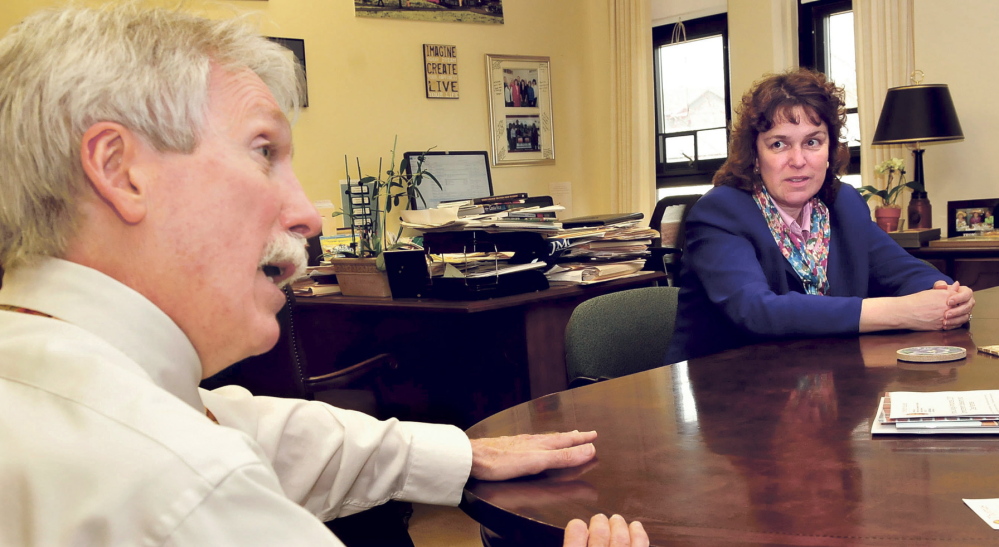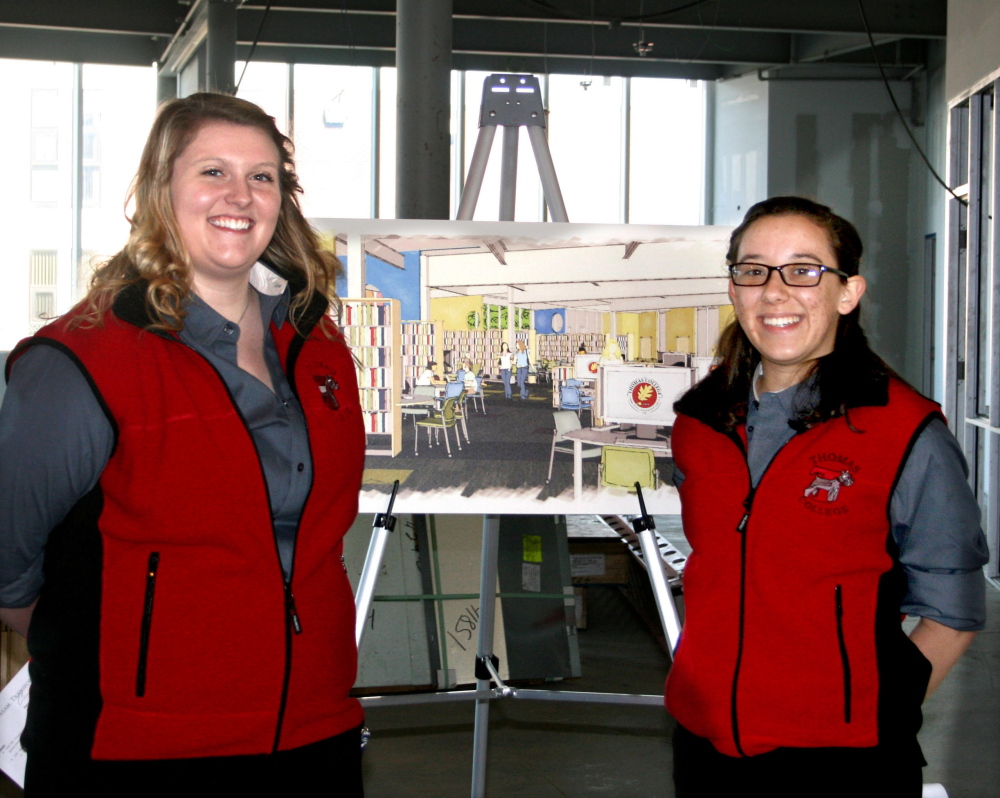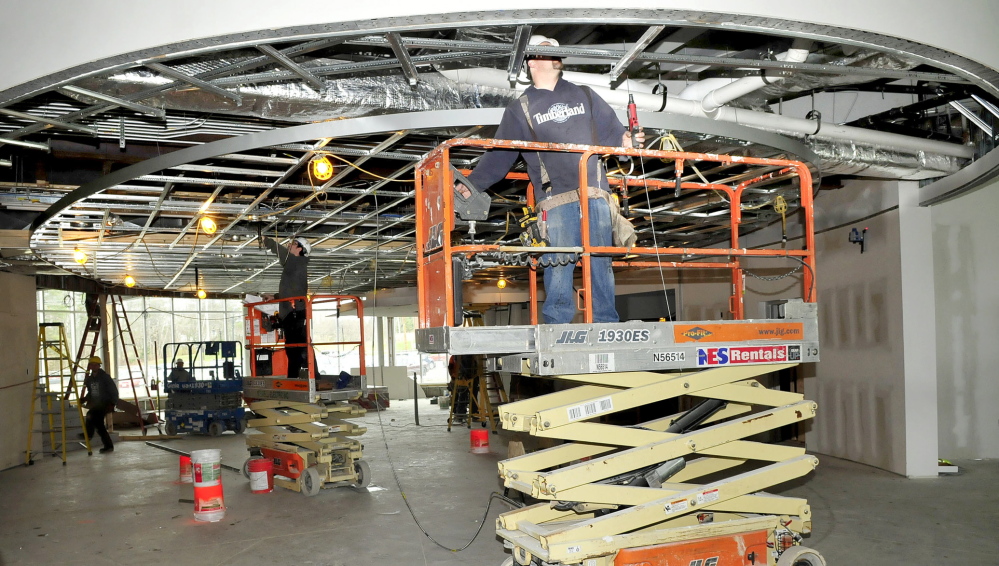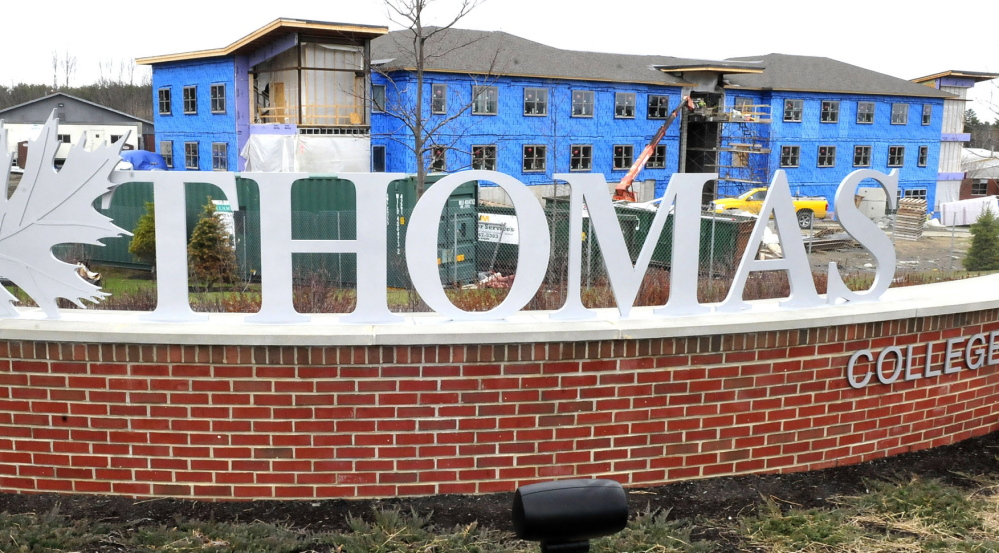WATERVILLE — When Thomas College freshman Krystal Peatfield first toured the college in 2012, there was a giant dirt pile in the middle of campus.
Less than two years later, as the college wrapped up another school year and with commencement less than a week away, that pile of dirt has been transformed into a 35,000 square foot, $8 million Harold Alfond Academic Center.
While the outside structure is almost complete, with large pane glass windows looking in to where a new 24-hour library and cafe will be housed, construction will continue through the summer for a fall 2014 opening. The next time most of the roughly 800 Thomas College students step on campus, the new academic center, as well as a new residence hall, will be completed.
“I think we’re all pretty anxious for it to open. It’s kind of a big deal,” said Taylor Arey, a junior education student from Caribou. “It’s the first academic building built on campus in over 40 years. We’re all just anxious to have classes there and use the library and cafe.”
The construction of the academic center and new residence hall is one of the first phases of Thomas College’s master plan, unveiled in 2011 as a way to increase student enrollment and construct at least a half-dozen new facilities on campus. All construction is enrollment-based, meaning certain enrollment benchmarks need to be met to trigger the construction or development of new facilities. The college’s long-term plan is to increase enrollment to 1,200-1,400 students.
“The college did some strategic planning and identified that in order to be sustainable we needed to reach a certain enrollment to provide quality education and resources that students need at an affordable price,” said Thomas Edwards, the college’s provost. “The campus master plan evolved in response to that.”
Thomas College President Laurie LaChance said in the college’s five-year plan that was approved in 2013 that their immediate goal is to increase enrollment from the 800-student mark to around 1,000.
THE HAROLD ALFOND ACADEMIC CENTER
With the additional construction projects enrollment driven, the college is increasing student numbers to trigger more construction. This past year, Thomas College had its largest incoming class of 297 full-time students, and the college is projecting to come close to that or surpass it with next year’s class, which is expected to be about 300 students, according to Director of Public Relations Jennifer Buker. With roughly 800 students enrolled full-time, enrollment has increased by about 14 percent since 2010.
This past summer, construction started on the Alfond Academic Center after the college matched the Alfond Foundation’s $4 million donation for the new academic center.
The academic center is a sprawling two-storied building with a circular, glass center with two long arms stretching in opposite direction that will house classrooms, study areas, the financial center, mentoring and tutoring offices, information and technology staff and several classrooms. The circular center will house the library, service area, cafe and a common area on the first floor with additional reading space on the second floor. A function and seminar room are in the center of the second floor separating the two corridors.
“We had students involved telling us what type of campus environment and campus community they wanted,” Edwards said, adding that these discussions with students and faculty started in 2010. “We saw the need for a library and new teaching space, and we asked students to identify the highest priorities when we design the building. They wanted meeting space and classroom areas near the library, and faculty offices near learning spaces. We listened to those things and got the priorities. There’s lots of space, lots of light, large classrooms and areas for group work. There’s even coffee in the library.”
Currently, the library is housed in a small, congested corner of the Ayotte Center, with the Career Service tucked into a corner and no room to spread out for group projects or discussions. A dank, dark stairway leads you to a room lined with book stacks and very little seating.
“It’s tiny,” Arey said of the old library. “In the new building, most of the rooms and enhancements are for the students. This building is geared toward students, and it’s a place where students and professors can come together.”
With a cramped library and little tranquility in the residence halls, Peatfield, 19, a criminal justice student, is looking forward to having another space to study in peace.
“In the dorms, I have problems studying. The walls are thin so you can hear doors slamming and all those things,” she said. “I’m looking forward to the extended hours.”
Arey echoed Peatfield’s sentiment.
“It’s exactly what we need,” she said, adding that having everything you need as a student in one place eases those tough nights of cramming. “Just being in one area and not have to leave is amazing.”
NEW RESIDENCE HALL
While several years of planning and discussion went into when exactly the right time was to build the Alfond Academic Center, the need for a new residence hall determined the speedy construction of the 32,000-square foot dormitory that can house more than 100 students.
“Because of the planning that had been done, we knew where every building would go once its time came,” LaChance said. In her second year as Thomas College president, the campus master plan predates her. Yet she credits the tremendous amount of planning and research that went into the plan before she got there that made a challenge like constructing a three-story residence hall in less than a year much easier.
“As we proceeded through last summer, we thought we’d have a nice class coming in, a large class,” LaChance said. “But we had no idea until the end of the summer that we’d have a record class.”
Last fall 297 students enrolled, the largest in the college’s history and 16 percent higher than 2008’s freshman class. With a large influx of students right before classes started, the college ended up with 60 triples, meaning three students were sharing a particularly small space.
“That’s just not good for a long-term plan for student retention,” LaChance said. “They need their space.”
In September, LaChance presented the board of trustees with four options for next year to make sure the housing-student ratio was appropriate. One option was to build a new residence hall, the second was to build a less appealing town house on campus that doesn’t have the longevity of a residence hall, the third was to house students somewhere off campus and the fourth was to change the way the college recruited students to ensure this problem wouldn’t happen again.
“It became very clear that the best option was to invest in a residence hall,” LaChance said. “In mid-October, we pressed go.”
By the beginning of the fall 2014 semester, a three-story, 108-student residence hall will be completed, capping off a project that broke ground less than a year before. More than 32,000 square feet, the residence hall was built with first-year students in mind, according to Edwards.
“We took a look at how residences halls are built, and we wanted to focus on the needs of first-year students,” Edwards said. “We want to make sure the students have maximum opportunity for interaction with others.”
The first floor is all common area for first-year students to mingle with others in an open environment with mostly double rooms and a couple single rooms on the second and third floor. In two corners on each floor, the common area is enclosed by large glass panels, allowing plenty of sunlight and scenery to shine through, while also letting first-year students take a peek at what may be happening on campus at any moment. The residence hall is near one of the main entrances to the campus off West River Road, about a two-minute walk to the Student Commons and a five-minute walk to the new Alfond Academic Center.
“A key component of the master plan was to identify central areas of the campus and build the classrooms, dining halls and academic centers at the center of the campus and have the residence halls feed into that area,” Edwards said.
The tidy use of space at Thomas College helped separate it from other schools Peatfield toured.
“When I toured other schools, it was cold and rainy and it took a while going from one building to the other,” she said. “I didn’t think I could handle that.”
LOOKING AHEAD
Once the new academic center is complete, the college will begin converting the Ayotte Center, which houses several classrooms, administration offices and the existing library, into the administrative center of campus.
“We’re being very thoughtful on the way we re-purpose this building so that all student services are together,” said LaChance.
Other plans include updating the existing residence halls to include more common area, the construction of four more residence halls near the foreground of the Kennebec River and a new athletic complex and field house looking over two of the college’s athletic fields.
The anticipation of being able to use the new academic center is almost boiling over for Arey and Peatfield.
“I was here before it was even a dirt pile,” Arey said. “It’s just amazing what it’s going to turn out to be.”
Having been employed at Thomas College since 2000, Edwards has witnessed the entire transformation of the college from a small business and liberal arts school to a thriving institution that continues to grow in enrollment while other schools report declines in enrollment. The University of Maine System reported in September that it had a roughly 3 percent decline in enrollment from the 2012-2013 school year. A portion of Thomas’ growth can be attributed to the continued rise in enrolling students from out of state and internationally.
“If we go back 10 years, enrollment at Thomas was 90 percent Maine and 10 percent out of state, including internationally,” Edwards said. “The most recent class, the percentage changed to 75 percent from Maine and 25 percent out of state. That gradual transition allows us to raise our enrollment and create a more diverse student body.”
As her second year as president of Thomas College comes to a close, LaChance is confident that the college will continue to grow — even with the more well-known Colby College down the road and the state’s largest university just an hour north — as more people recognize and understand the commitment the college is making toward enhancing its student experience.
“In my first year, I met with many business and political leaders throughout the state, and many of them said that we were a little secret in Waterville,” LaChance said. “We don’t want to be the best kept secret anymore.”
Jesse Scardina — 861-9239jscardina@centralmaine.comTwitter: @jessescardina
Send questions/comments to the editors.






Comments are no longer available on this story